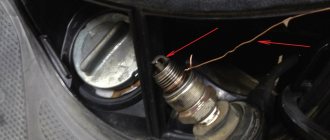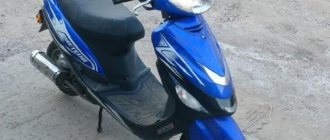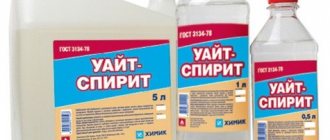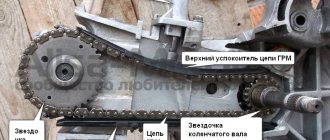General recommendations for scooter maintenance Proper running-in of the scooter Adjusting the scooter valve clearances Centrifugal clutch - removing, installing, replacing pads Is the flying season over? It's time to think about preserving your scooter Spring delights or How to start a scooter after winter Instructions on changing the engine oil of a scooter Instructions on changing the transmission oil of a scooter Instructions on cleaning the air filter of a scooter Checking and replacing a scooter's variator belt Replacing a scooter's variator belt without disassembling the variator Scooter tires Maintenance of cables, locks and other scooter mechanisms Replacement of wheel bearings and brake disc Repair and maintenance of chain scooter transmission
You, as the owner of a scooter, should be interested in how to make sure that the scooter you buy serves you for a long time and trouble-free, looks good and, if possible, delivers only positive emotions.
And if you had motorcycle experience in your youth, that’s good. But since then, technology has stepped far forward - now there is no need to mix gasoline and oil before refueling a scooter, cursing wildly. Modern scooters have an electric starter, disc brakes and a separate lubrication system - more and more scooter models are equipped with a four-stroke engine.
Technology has stepped forward, but it is still technology, which means a scooter (like any equipment) requires care to ensure long and trouble-free service. And the first piece of advice on this matter is quite simple: you need to use consumables, oils, additives specifically designed for scooters, etc. This technique has its own specifics.
Scooter oil
Modern scooters usually use 2 types of oil - motor and transmission, for the engine and transmission, respectively. For the normal operation of these components, the oil, of course, should be changed regularly, using the oil class recommended by the manufacturer (Read more about scooter oils). Engine oil change intervals
The scooter is also installed by the manufacturer, but on average every 3000 km (when using really high-quality oil). During the break-in period of a scooter (or a new engine), the oil is changed more often. That is, for a new scooter, the frequency of replacing the motor (and, by the way, the transmission too) is approximately the following:
after the 300 km mark after the 1000 km mark after the 2000 km mark then every 2-4 thousand km.
After break-in, the transmission oil is changed a little less frequently than the engine oil, approximately every 4-6 thousand km. The process of changing the engine and transmission oils of a scooter.
Checking the throttle cable for binding
Turn the throttle and release it. It should freely return to its original position.
If the handle returns stuck, then you need to disassemble the throttle handle and remove the cable. To do this, remove the mirrors and disassemble the instrument panel.
Use a rag to remove all dirt and old grease from the throttle grip.
Lubricate the cable. Using a syringe, pour engine oil into the cable housing.
Check the cable again for binding by pulling it by hand. If it still sticks, replace it with a new one.
Lubricate the throttle mechanism with the same oil.
Reassemble everything and check the throttle return function again.
The condition of the air filter is very important for a scooter.
The air filter is an important element in the scooter's power system. The filter must always be clean, not have even a little dirt, especially not be clogged with dirt, dust, poplar fluff and other evil spirits. Otherwise, this dirt will prevent the free flow of fresh air into the carburetor, which will change the air/gasoline ratio in the combustible mixture (making it richer); also, this dirt will certainly penetrate into the carburetor, clog the jets, tubes, etc., which in turn will also change the air/gasoline ratio in the combustible mixture (make it lean); and finally, in the worst case scenario, foreign small particles will penetrate into the combustion chamber, which can damage the cylinder walls and reduce compression; in other words, the engine will grunt. So, clean your air filter more often.
Scooters often use “zero” resistance filters made of special foam rubber. Such a filter requires very regular maintenance: washing and impregnation of the foam rubber with a special oil that can gel.
Oil for impregnating filters is produced according to a special recipe, although it is quite normal to use regular engine or transmission oil. Oil prevents water, dust and dirt from entering the engine. The due date for the next scooter filter service can be determined by the “fading” of the filter color. Learn more about cleaning your scooter's air filter.
This article describes how to wash and soak your scooter's air filter.Most Chinese four-stroke engines have a “wet” type filter element installed (it is also possible to install a dry type element). What does this mean? It’s very simple - wet, which means the filter element is saturated with oil, which traps small dust particles contained in the filtered air. The filter element itself is made of oil- and petrol-resistant foam rubber, or rather of two layers.
The outer layer has larger cells and traps large particles; the inner layer has smaller cells and allows for the retention of fine dust. Over time, the filter element becomes clogged and a lot of dust settles in it. Therefore, its throughput is reduced, that is, less air enters the carburetor, thereby disrupting its settings. Therefore, it is necessary to replace or clean the air filter element.
The manufacturer recommends replacing the filter element every 5,000 km. Naturally, if you drive on dusty roads, then you need to replace (clean) more often. But what to do if it is impossible to purchase a new filter? There is only one answer - clean the old one and treat it with oil.
Work order
First, we clean the air filter housing from dirt and disassemble it. To do this, use a Phillips screwdriver to unscrew 6 screws located around the perimeter. Remove the cover. There should be no latches on it, so it can be easily removed. The only thing you need to pay attention to (both when removing the cover and when removing the filter element) is to try not to damage the element.
Inspect the filter element. If damage is noticeable (loose fit to the edges of the filter housing, ruptures, through holes), then it must be replaced. Next, carefully remove the foam rubber.
Left: Filter element, outer side
Right: Filter element, inner side
We should wash it. How to do this is written below. For now, let's take a look at the filter housing. We wipe it from the inside with a cloth soaked in gasoline, and then wipe it dry with a cotton cloth (an old T-shirt). Make sure that no dust or threads remain, they can get into the carburetor and clog the channels or jets.
Cleaning the filter element
There are several ways to do this, which differ in the amount of material costs.
Method one. We purchase an air filter cleaner, such as K&N. This product, like the impregnating oil of this company, is intended not only for filters of the K&M system (these filters are made of several layers of gauze located between the meshes), but also for foam rubber ones. We use this product according to the instructions.
Method two. We wash the filter element in gasoline. I would like to note that in the intake system of a scooter, the filter may come into contact with gasoline (gasoline is ejected from the carburetor). Despite this, foam rubber can be dissolved by gasoline, so it is necessary to check (at the edge of the element) its gasoline resistance. Pour gasoline into a suitable container and wash the foam. You need to wash it carefully and carefully, do not cheat (like socks:). It is quite easy to press on the foam and release. After washing, wring out the element. This must be done carefully, and under no circumstances twist the foam. Dry the filter element.
Method three. This is what I personally do, there are no costs, and the quality of cleaning is excellent. Wash the element in warm water with washing powder.
When washing, follow the same rules as when washing in gasoline. After washing, wring out, rinse well and dry the filter element. It is better to dry on a radiator (drying time is reduced). It should be remembered that you need to treat foam rubber with care. Otherwise, the element may become deformed or delaminate. The more carefully you wash the filter, the longer it will last.
Well, we washed the foam rubber and dried it well. Now we move on to the next stage - impregnation (it is important that the foam rubber is completely dry).
What to soak with? And again we have two options - use special oil (optimally) or regular motor oil. Transmission use is not recommended. For my filter I use air filter impregnation oil
(from K&M), of course a little expensive, but convenient to work with. This oil is in an aerosol can and is colored red, which allows you to control the uniformity of application. Perhaps you can purchase analogues from other companies, a little cheaper. But if you decide to use an aerosol, remember - only air filter oil will do. So, spray the oil evenly in linear (not circular) movements onto the surface of the filter element. We wait 20 minutes and control the uniformity of application. We “paint over” all the spots that did not get oil. When applying oil, it flies in all directions, so cover it with old newspapers. Or better yet, plastic film.
When using motor oil, also saturate the filter element evenly. Soak in a suitable container. Before impregnation, dilute the oil with gasoline 1:1 to reduce its viscosity and improve absorption. There is no need to pour too much oil; the filter’s throughput may deteriorate. After impregnation, we compress the foam so that the oil is better absorbed and to remove its excess. Let's do the math: a can of 200 ml of oil is designed for 4 - 5 impregnations, depending on the size of the filter. Therefore, for impregnation we need 40 - 50 ml of oil, possibly less.
Now we install the filter element into the filter housing. The side with larger pores should face outward. Install carefully so as not to tear the foam.
We put the cover in place and screw it on. Do not overtighten the screws to avoid breaking the plastic. I have one post into which the screw is screwed was already broken, I don’t know why (either vibration, or the zealous assembler at the factory was overworked).
Conclusion. Please note that in the suction pipe (the pipe through which air enters the air filter), or rather at the very beginning, there is another filter installed, a coarser one (not on all models).
Left: Air filter cover
Right: This is where the “pre-filter” should be located.
Its task is to retain water and large dirt. The filter element here is synthetic fibers. This filter must be disassembled and washed. While disassembling my air filter, I discovered that I had lost this "pre-filter" somewhere. Now we will have to make a new one from scrap materials. As soon as I do, I will immediately write an addition to this article.
Author: Artem Petrov
Scooter variator belt maintenance
Scooter variator belt is a consumable item. The belt, so to speak, directly pulls the scooter on itself, and accordingly wears out over time. Typically, the service life of the belt is 8-12 thousand km. Much depends on the manufacturer of the belt, as well as on the riding style of the scooterist. Read more about servicing the scooter's variator belt. In general, you can keep a notebook and note the mileage in it every time you change the belt, engine and transmission oils. This is to make sure you don’t forget - a short pencil is better than a long memory.
How often does it need to be replaced?
The frequency of replacing the air filter depends on the degree of use of the 4 T scooter, as well as the responsibility of its owner and the quality of the roads. If the vehicle is operated on dusty country roads from morning to night, then the period of use of the air purifier will be short.
Average statistical data indicate that it is necessary to change the cleaning structure every 5 thousand kilometers if the vehicle is not used regularly. The service life will also be affected by the quality of the filter itself. Original models will last much longer.
Maintenance of cables, locks and other scooter mechanisms
Over time, the scooter's cables become increasingly tight, and the locks become increasingly difficult to operate. This is due to the production of lubricating components, which either dry out or simply lose their properties. So, for example, by the next season the throttle cable may begin to “get stuck”, and the gas will jam, or maybe even get stuck in the “pressed” position. Therefore, to avoid this, it is recommended to perform a simple procedure to lubricate this mechanism annually. Read more Maintenance of cables, locks and other scooter mechanisms
Trouble on the road
A scooter (like a motorcycle), if a tire is punctured, completely loses the ability to move independently. But carrying a pump or a spare tire with you is not a luxury that every scooter model can afford. But the situation is not as hopeless as it seems. The solution is a special sealant for repairing motorcycle tires. One can both seals and inflates a motorcycle tire, and what is especially important does not take up much space in the glove compartment of a scooter. Also see the article: Scooter's emergency suitcase
Gasoline quality.
Low-quality gasoline not only worsens the dynamics of the scooter, sometimes it can literally destroy the engine in a matter of minutes. Therefore, the use of fuel additives (despite the fact that no one can guarantee the quality of gasoline) is not only justified, but necessary. It would also be good to fill the fuel not at a gas station, but in your garage through a special filter nozzle that does not allow water and debris to pass through. Such a watering can can be purchased at a car store.
The use of high-quality fuel additives not only eliminates scooter engine problems, but also allows you to significantly save fuel. A good additive keeps the combustion chamber and entire fuel system clean. A clean carburetor provides a mixture of optimal composition and allows you to save on adjustments to the scooter’s carburetor. It is convenient to purchase additives that come in packaging with a dispenser.
002_MOTO_0410_061
Remove the filter carefully. Dirt from the joints tends to fall into the engine. A vacuum cleaner will help remove it in advance.
Remove the filter carefully. Dirt from the joints tends to fall into the engine. A vacuum cleaner will help remove it in advance.
A gas mask, respirator, gauze bandage are all options for air filters for people. It's hard to breathe with any of them. And if the bandage is too tight, the lack of air becomes more and more intense, oxygen starvation sets in and your strength leaves you. The same thing happens with a motorcycle engine, because the air supply to it directly depends on the condition of the air filter. Therefore, we should not forget about the important duty of any motorcyclist - to monitor the condition of the “lungs” of his ward.
So, the filter cleans the incoming air, but also makes it difficult to move. The dirtier the filter, the less air reaches the cylinder. Here are some typical manifestations of such a malfunction:
• Power is reduced, which is most noticeable when accelerating from medium speeds.
• When you suddenly open the gas at idle, soot comes out of the muffler.
• Increased fuel consumption within 10%.
• It is possible (if the contamination is very strong) that oil loss will increase. This is due to its suction (through seals and the ventilation system) due to the strong vacuum in the intake tract.
Equipment, etc.
Various insects cause quite a lot of inconvenience when riding a scooter. They constantly strive to break on the visor of the helmet and dry on it for a long time. In this case, as well as to protect the helmet glass from water, dirt and fogging, a helmet cleaner can be used. For leather lovers, there are leather care products. These are lotions that make the skin softer, prevent it from drying out and cracking, protect the skin from water and improve its appearance. Skin treated with this lotion is cleansed and looks like new.
For lovers of fabric clothing, there are various means of impregnating clothing and tents. They will save you from getting wet and dirty in bad weather, maintain the breathability and softness of the fabric, and prevent the formation of oil and grease stains. Such aerosols are suitable not only for fabric, but also for impregnating suede.
010_MOTO_0410_062
You can apply the oil with a paint brush.
You can apply the oil with a paint brush.
Impregnating the filter with oil is also a non-trivial task. Beginners make two main mistakes: they saturate the filter unevenly (not only over the area, but also in depth) or overfill the oil, so that after installing the filter it continues to flow out from under the cap for a long time. To prevent this from happening, first carefully pour oil onto the surface of the filter, making sure that it does not leak through (or spray the filter if the lubricant is in a can). As soon as the filter has collected approximately 10-15% of its volume of oil, place it in a transparent plastic bag and gently knead it with your hands, distributing the oil. Impregnation can be considered complete when the filter is evenly colored both outside and inside, and no oil flows out of it when pressed. We squeeze out the excess - we don’t need snot in the airbox, and besides, it can plug the drain valve, an important part on enduro. It is best to let the soaked filter sit for at least a couple of hours, or preferably a day.











